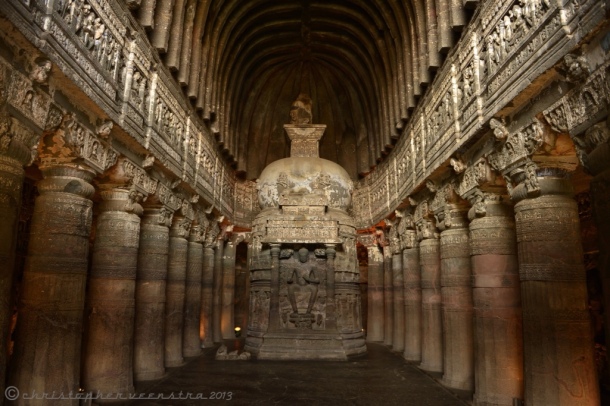The Buddhist caves of Ajanta were chiseled out of a horseshoe-shaped canyon beginning in the 2nd century B.C. and ending sometime in the 6th century A.D. As far as India goes, these were some of the earliest monastic institutions ever built. The construction of Ellora commenced in the 7th century A.D. and it was the undertaking of this newest of grand projects that pushed the caves at Ajanta to the back burner where it would be left to nature to hide it from prying eyes (and damaging hands) until discovered again in 1819. The 30 caves at Ajanta are all Buddhist, while the 34 Ellora caves are shared between three faiths (12 Buddhist, 17 Hindu, and 5 Jain). Ajanta is renowned for its unparalleled fresco paintings that, due to its concealed state from humanity for more than a millennium, are superbly preserved. Ellora, on the other hand, is famous for its ornate stone carvings- some on a larger-than-life scale. However, these are just simple generalizations. Ajanta has many impressive and intricate stone carvings as well, and the very fact that these caves were hand chiseled from the sheer cliff face of a solid rock gorge is a mind boggling accomplishment in itself. Ellora too has has some fine paintings but most have fallen victim to centuries of environmental wear.
But hands down, the single most impressive sight of the two areas has to be Ellora's staggering Kailasa Temple. This 8th century Hindu temple (dedicated to the Lord Shiva) is of epic proportions and is adorned with thousands of detailed statues and carvings. It measures in at one hundred feet high, 110 feet wide, and 165 feet long. But what makes this temple truly unique and remarkable is that it wasn't built from the ground up, or even carved out of the escarpment wall. This temple was meticulously carved from a solid chunk of rock from the top to the bottom. It took 7000 men over a 150-year period to pull off this architectural miracle, in the process displacing more than 200,000 tonnes of rock. There was no margin for error in its construction, and no errors were made. It was, and still is, a flawless piece of art, and no doubt the epitome of Indian rock-cut architecture. To quote the leading expert on the subject, the late Percy Brown, “The Kailasa is an illustration of one of those rare occasions when men's minds, hearts, and hands work in unison towards the consummation of a supreme ideal“. Too true Percy! The Kailasa temple remains the largest monolithic structure/ sculpture in the world. Today both Ellora and Ajanta are wildly popular for domestic and foreign tourists alike- and rightfully so. Despite the crowds though, being within a 1000 kilometer radius of these sites and not paying them a visit would be a massive mistake.
61 hours on public transport.




